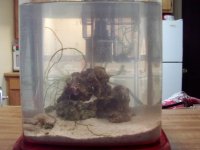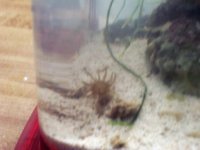Here are some sealing ideas I have had for the aquavase:
1. Acrylic lid made from jig
saw and thin acrylic from Home Depot. Invert the empty tank onto clear lexan/acrylic and trace with marker. Use jigsaw to cut out an exact fit for the shape of the aquavase tank.
Clamp light goes onto something else, a small wire stand perhaps, to clear up the fit for the lid. There would be no place for the mini HOB filter available for these models, the purpose of this design is to control salinity by restricting evaporation.
Lid should have a tiny hole for servicing needs and ventilation, along with a hole slightly smaller than a piece of airline tubing (used for circulation). Installation process includes actually gluing the lid to the tank, with a
tiny tiny streak of silicone, to totally seal it around the edges and prevent any salt creep. During weekly or bi-weekly service, a razor blade is ran around the lip to free the lid and allows service by removing the lid. It is then resealed for the next week's stay. Holes are not side-by side, but spaced apart to prevent splatter from reaching the vent/service hole.
2. Circulation
Provided by an airstone set on very low, just enough to move the water. Airline tubing should run through a grommet in the lid, or be siliconed in place to avoid saltcreep. Build reefwall around the tubing or use the method seen in the
Coral Nano Reef edition magazine. Consider possibly leaving the bubbler off the end of the tube. Slow, larger bubbles may move more water in the long run with less splatter but I don't know, just a thought. This setup may not work well with fish, as the design of their pico tank would necessitate more access to the water. I'd consider swapping the fish for a caulastrea frag.










